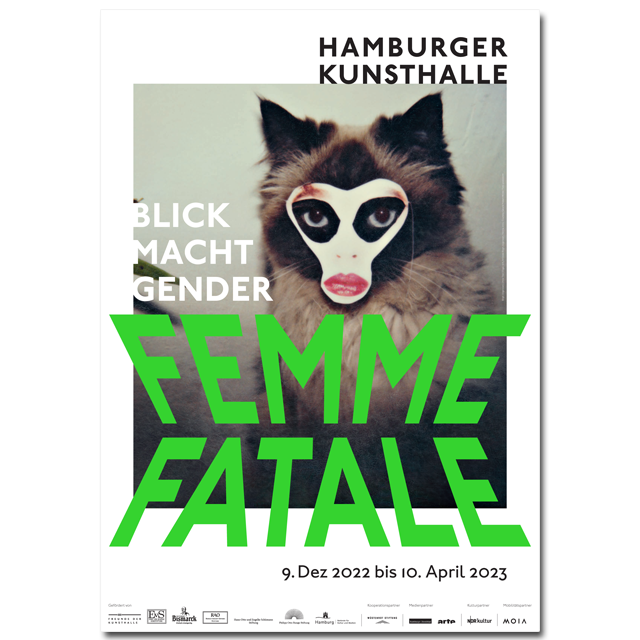
Data:
| Availability | Not available |
| Article number | 177541 |
| Price | 8,00 € |
Description:
FEMME FATALE
Gaze - Power - Gender
09 Dec 2022 - 10 April 2023 | Special exhibition
Exhibition poster | Dimensions: 59.5 x 84 cm
The femme fatale is a myth, a projection, a construction. She stands for a pictorially coded female stereotype: the sensual, erotic and desirable woman whose supposedly demonic nature reveals itself in the fact that she casts such a spell on men that they fall under her spell - often with fatal results. The exhibition "FEMME FATALE. Gaze - Power - Gender". The show not only explores the artistic manifestations of the theme from the early 19th century to the present, but also aims to critically illuminate the myth of the femme fatale in its genesis and historical transformation.
The 'classical' image of the femme fatale is primarily based on biblical and mythological female figures such as Judith, Salome, Medusa or the Sirens, who were widely perceived as fatal women in art and literature between 1860 and 1920. The demonisation of female sexuality associated with these narratives is formative for the femme fatale figure. Around 1900, the femme fatale image was often projected onto real people, often actors, dancers or artists such as Sarah Bernhardt, Alma Mahler or Anita Berber. What is striking is the simultaneity of important achievements of women's emancipation and the increased appearance of this male-dominated image of women. As a counter-image that playfully takes up aspects of the femme fatale figure, the New Woman emerging in the 1920s therefore also becomes important for the exhibition. A decisive break was made in the 1960s by feminist artists who deconstructed the myth of the femme fatale - and with it the corresponding ways of seeing and pictorial traditions. Current artistic positions, in turn, negotiate traces and appropriations of the image or establish explicit counter-narratives - often with reference to the #MeToo movement, questions of gender identities, female corporeality and sexuality, and in an examination of the male gaze.
In order to trace the constellations of gaze, power and gender that are constitutive for the image of the femme fatale and its transformations, the exhibition brings together around 140 exhibits across media and epochs. On display will be paintings by Pre-Raphaelite artists (including Evelyn de Morgan, Dante Gabriel Rossetti, John William Waterhouse) as well as Symbolist works (including Fernand Khnopff, Gustav Mahler, and others). Fernand Khnopff, Gustave Moreau, Edvard Munch, Franz von Stuck), Impressionism (Lovis Corinth, Max Liebermann, Édouard Manet, Max Slevogt, among others), Expressionism and New Objectivity (Dodo, Jeanne Mammen, Gerda Wegener, among others). With positions of the early feminist avant-garde (including VALIE EXPORT, Birgit Jürgenssen, Ketty La Rocca, Maria Lassnig, Betty Tompkins) as well as current works with queer and intersectional feminist perspectives (including Nan Goldin, Mickalene Thomas, Zandile Tshabalala), the arc is drawn to the present.
Gaze - Power - Gender
09 Dec 2022 - 10 April 2023 | Special exhibition
Exhibition poster | Dimensions: 59.5 x 84 cm
The femme fatale is a myth, a projection, a construction. She stands for a pictorially coded female stereotype: the sensual, erotic and desirable woman whose supposedly demonic nature reveals itself in the fact that she casts such a spell on men that they fall under her spell - often with fatal results. The exhibition "FEMME FATALE. Gaze - Power - Gender". The show not only explores the artistic manifestations of the theme from the early 19th century to the present, but also aims to critically illuminate the myth of the femme fatale in its genesis and historical transformation.
The 'classical' image of the femme fatale is primarily based on biblical and mythological female figures such as Judith, Salome, Medusa or the Sirens, who were widely perceived as fatal women in art and literature between 1860 and 1920. The demonisation of female sexuality associated with these narratives is formative for the femme fatale figure. Around 1900, the femme fatale image was often projected onto real people, often actors, dancers or artists such as Sarah Bernhardt, Alma Mahler or Anita Berber. What is striking is the simultaneity of important achievements of women's emancipation and the increased appearance of this male-dominated image of women. As a counter-image that playfully takes up aspects of the femme fatale figure, the New Woman emerging in the 1920s therefore also becomes important for the exhibition. A decisive break was made in the 1960s by feminist artists who deconstructed the myth of the femme fatale - and with it the corresponding ways of seeing and pictorial traditions. Current artistic positions, in turn, negotiate traces and appropriations of the image or establish explicit counter-narratives - often with reference to the #MeToo movement, questions of gender identities, female corporeality and sexuality, and in an examination of the male gaze.
In order to trace the constellations of gaze, power and gender that are constitutive for the image of the femme fatale and its transformations, the exhibition brings together around 140 exhibits across media and epochs. On display will be paintings by Pre-Raphaelite artists (including Evelyn de Morgan, Dante Gabriel Rossetti, John William Waterhouse) as well as Symbolist works (including Fernand Khnopff, Gustav Mahler, and others). Fernand Khnopff, Gustave Moreau, Edvard Munch, Franz von Stuck), Impressionism (Lovis Corinth, Max Liebermann, Édouard Manet, Max Slevogt, among others), Expressionism and New Objectivity (Dodo, Jeanne Mammen, Gerda Wegener, among others). With positions of the early feminist avant-garde (including VALIE EXPORT, Birgit Jürgenssen, Ketty La Rocca, Maria Lassnig, Betty Tompkins) as well as current works with queer and intersectional feminist perspectives (including Nan Goldin, Mickalene Thomas, Zandile Tshabalala), the arc is drawn to the present.

